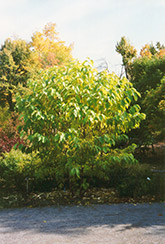It's all about ...
plants

Fragrant Epaulette Tree
Pterostyrax hispida
Height: 20 feet
Spread: 20 feet
Sunlight:
![]()
![]()
Hardiness Zone: 5a
Other Names: Epaulettetree
Description:
A truly rare and unusual small ornamental tree for use in the home landscape with long chains of delicate creamy white flowers in early summer followed by chains of grayish fruit, dense and compact; extremely showy in more than one season
Ornamental Features
Fragrant Epaulette Tree features delicate panicles of fragrant creamy white frilly flowers hanging below the branches from late spring to early summer. It has light green deciduous foliage. The large pointy leaves turn yellow in fall. The gray fruits are held in clusters from late summer to late fall. The smooth gray bark adds an interesting dimension to the landscape.
Landscape Attributes
Fragrant Epaulette Tree is a dense deciduous tree with a more or less rounded form. Its relatively coarse texture can be used to stand it apart from other landscape plants with finer foliage.
This is a relatively low maintenance tree, and should only be pruned after flowering to avoid removing any of the current season's flowers. It has no significant negative characteristics.
Fragrant Epaulette Tree is recommended for the following landscape applications;
- Accent
Planting & Growing
Fragrant Epaulette Tree will grow to be about 20 feet tall at maturity, with a spread of 20 feet. It has a low canopy with a typical clearance of 2 feet from the ground, and is suitable for planting under power lines. It grows at a medium rate, and under ideal conditions can be expected to live for 40 years or more.
This tree does best in full sun to partial shade. It does best in average to evenly moist conditions, but will not tolerate standing water. It is not particular as to soil type, but has a definite preference for acidic soils, and is subject to chlorosis (yellowing) of the foliage in alkaline soils. It is somewhat tolerant of urban pollution, and will benefit from being planted in a relatively sheltered location. Consider applying a thick mulch around the root zone in winter to protect it in exposed locations or colder microclimates. This species is not originally from North America.
This plant is not reliably hardy in our region, and certain restrictions may apply; contact the store for more information.
